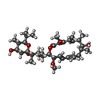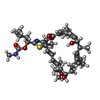+Search query
-Structure paper
| Title | Cryo-EM of the Yeast V Complex Reveals Distinct Binding Sites for Macrolide V-ATPase Inhibitors. |
|---|---|
| Journal, issue, pages | ACS Chem Biol, Vol. 17, Issue 3, Page 619-628, Year 2022 |
| Publish date | Mar 18, 2022 |
 Authors Authors | Kristine A Keon / Samir Benlekbir / Susanne H Kirsch / Rolf Müller / John L Rubinstein /   |
| PubMed Abstract | Vacuolar-type adenosine triphosphatases (V-ATPases) are proton pumps found in almost all eukaryotic cells. These enzymes consist of a soluble catalytic V region that hydrolyzes ATP and a membrane- ...Vacuolar-type adenosine triphosphatases (V-ATPases) are proton pumps found in almost all eukaryotic cells. These enzymes consist of a soluble catalytic V region that hydrolyzes ATP and a membrane-embedded V region responsible for proton translocation. V-ATPase activity leads to acidification of endosomes, phagosomes, lysosomes, secretory vesicles, and the trans-Golgi network, with extracellular acidification occurring in some specialized cells. Small-molecule inhibitors of V-ATPase have played a crucial role in elucidating numerous aspects of cell biology by blocking acidification of intracellular compartments, while therapeutic use of V-ATPase inhibitors has been proposed for the treatment of cancer, osteoporosis, and some infections. Here, we determine structures of the isolated V complex from bound to two well-known macrolide inhibitors: bafilomycin A1 and archazolid A. The structures reveal different binding sites for the inhibitors on the surface of the proton-carrying c ring, with only a small amount of overlap between the two sites. Binding of both inhibitors is mediated primarily through van der Waals interactions in shallow pockets and suggests that the inhibitors block rotation of the ring. Together, these structures indicate the existence of a large chemical space available for V-ATPase inhibitors that block acidification by binding the c ring. |
 External links External links |  ACS Chem Biol / ACS Chem Biol /  PubMed:35148071 PubMed:35148071 |
| Methods | EM (single particle) |
| Resolution | 2.8 - 3.2 Å |
| Structure data | EMDB-25779, PDB-7tao: EMDB-25780, PDB-7tap: |
| Chemicals |  ChemComp-WEV:  ChemComp-KJL: |
| Source |
|
 Keywords Keywords | MEMBRANE PROTEIN / inhibitor / complex / proton pump / ATPase |
 Movie
Movie Controller
Controller Structure viewers
Structure viewers About Yorodumi Papers
About Yorodumi Papers








